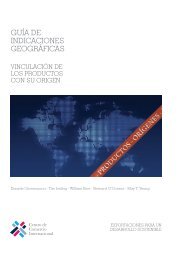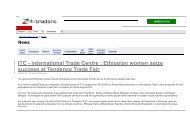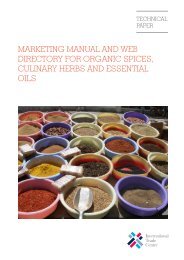Gender Mainstreaming: The Role Entrepreneurs Can Play and Why ...
Gender Mainstreaming: The Role Entrepreneurs Can Play and Why ...
Gender Mainstreaming: The Role Entrepreneurs Can Play and Why ...
Create successful ePaper yourself
Turn your PDF publications into a flip-book with our unique Google optimized e-Paper software.
<strong>Gender</strong> <strong>Mainstreaming</strong>:<br />
<strong>The</strong> <strong>Role</strong> <strong>Entrepreneurs</strong> <strong>Can</strong> <strong>Play</strong> <strong>and</strong> <strong>Why</strong> It is Important<br />
Introduction<br />
With respect to the role that entrepreneurs can play in ‘gender mainstreaming’, it is more<br />
accurate to think in terms of ‘partnering’ <strong>and</strong> of women accessing ‘spheres of influence’.<br />
Often women are excluded from traditional or mainstream organizations, networks, events,<br />
business opportunities, jobs or even statistics because they are not visible, their contribution<br />
is unknown much less unrecognized or they are simply forgotten! Sometimes, omission of<br />
women is intentional <strong>and</strong> sometimes it is just negligence or ignorance. In simplistic terms,<br />
think of ‘gender mainstreaming’ as just a more strategic evolution of networking.<br />
What is <strong>Gender</strong> <strong>Mainstreaming</strong>?<br />
‘<strong>Gender</strong> mainstreaming’ is a formally recognized, widely used <strong>and</strong> highly technical term<br />
which can have a variety of meanings. In general, “gender mainstreaming” means that<br />
women <strong>and</strong> men have equitable access to <strong>and</strong> benefit from society’s resources, opportunities<br />
<strong>and</strong> rewards <strong>and</strong> equal participation in influencing what is valued, <strong>and</strong> in shaping directions<br />
<strong>and</strong> decisions. 1 It also refers to the integration of a gender perspective or awareness into the<br />
way in which a society or organization operates. In reference to women-owned service<br />
businesses, “gender mainstreaming” refers to support activities that are integrated into<br />
government <strong>and</strong> association policy <strong>and</strong> operations. All too often, initiatives to assist small<br />
businesses focus only on businesses owned by men, <strong>and</strong> initiatives specifically to help<br />
women are isolated from ongoing programming.<br />
<strong>Gender</strong> mainstreaming involves the full participation of women in all aspects of life <strong>and</strong><br />
addresses access issues to increase women’s participation in sectors where they are<br />
weakly represented. With respect to businesswomen, this is often in the area of export,<br />
international trade <strong>and</strong> trade missions. At the core of “gender mainstreaming” is a<br />
commitment to change attitudes so that women <strong>and</strong> men are equal participants in any<br />
initiatives for the private sector <strong>and</strong> to adopt gender-sensitive indicators for the purpose of<br />
ongoing monitoring <strong>and</strong> evaluation of gender mainstreaming.<br />
One of the most important principles to remember when discussing gender mainstreaming<br />
<strong>and</strong> developing a strategy to integrate businesswomen into main stream networks, is that it<br />
should never be confrontational. <strong>The</strong> idea is not an ‘either / or’ situation but to realize that<br />
what is good for women in business is good for all business <strong>and</strong> that by working together<br />
equally with businessmen <strong>and</strong> having the same opportunities, then the economy, business<br />
<strong>and</strong> development will be better for all.<br />
1 Gibb, Heather, <strong>Gender</strong> <strong>Mainstreaming</strong> Good Practices from the Asia Pacific Region, <strong>The</strong> North-South Institute, 2001<br />
54-56 rue de Montbrillant Postal address: Palais des Nations Telephone: +41 22 730 01 11 E-mail: itcreg@intracen.org<br />
CH-1202 Geneva, Switzerl<strong>and</strong> CH-1211 Geneva 10, Switzerl<strong>and</strong> Fax: +41 22 733 44 39 Internet: http://www.intracen.org
INTERNATIONAL TRADE CENTRE UNCTAD/WTO Page 2<br />
<strong>Why</strong> is <strong>Gender</strong> <strong>Mainstreaming</strong> Important?<br />
For women to grow their businesses <strong>and</strong> exp<strong>and</strong> in an increasingly competitive world, they<br />
have to have equal access to the opportunities, support <strong>and</strong> benefits that male owned<br />
businesses have. While women focused business associations <strong>and</strong> networks can be very<br />
helpful <strong>and</strong> supportive to women owned service businesses <strong>and</strong> women often start their<br />
businesses by providing services to other women owned businesses, it is crucial that<br />
women become integrated into the Chambers of Commerce, professional networks,<br />
associations, trade initiatives <strong>and</strong> trade opportunities that men have access to. Being<br />
recommended by male colleagues or being active in ‘mainstream’ networks can<br />
automatically increase the credibility of women owned service businesses <strong>and</strong> broaden<br />
their markets.<br />
When women entrepreneurs are included in mainstream fora, chambers, discussions <strong>and</strong><br />
networks, <strong>and</strong> research, they have a profound influence in a variety of ways. Participation<br />
brings increased awareness of the role <strong>and</strong> success of women. It increases the visibility of<br />
women <strong>and</strong> increases the potential for more business <strong>and</strong> growth. Participation of women<br />
entrepreneurs can influence the way new policy is made <strong>and</strong> alter government programs<br />
so that they do not exclude or hinder women entrepreneurs. Discussions at conferences<br />
take on a different tone <strong>and</strong> become more relevant to the needs of women entrepreneurs.<br />
Women are interesting! <strong>The</strong>ir businesses are interesting. <strong>Why</strong> exclude willing players<br />
who want to make a positive contribution? It is just more fun to have women involved!<br />
Recognizing the Barriers<br />
Barriers to women <strong>and</strong> their participation exist in a variety of ways: formal or implied.<br />
Typically, women entrepreneurs are excluded from mainstream networks, trade missions,<br />
conferences, associations, chambers <strong>and</strong> business development initiatives for economic<br />
reasons – the price is just to high to participate! <strong>The</strong> cost of joining or participating in<br />
events is often beyond what most small (hence women owned) businesses can afford.<br />
Even when women are willing to pay the entry price, they may deem that there are better<br />
uses of their money with a better return on their investments. <strong>The</strong> ‘culture’ of established<br />
networks can be intimidating <strong>and</strong> uninviting to women. Timing <strong>and</strong> venues of events may<br />
be inconvenient for women with families<br />
<strong>The</strong> <strong>Role</strong> That Women <strong>Entrepreneurs</strong> <strong>Can</strong> <strong>Play</strong><br />
<strong>Entrepreneurs</strong> can play a unique role in breaking down the barriers to women <strong>and</strong> increasing<br />
the full participation of women in business. By nature, entrepreneurs are innovative <strong>and</strong><br />
innovators who are risk takers! <strong>The</strong>y are leaders who are in a unique position to lead by<br />
example. <strong>Entrepreneurs</strong> are creative <strong>and</strong> want to do business! <strong>The</strong>y do not have to be<br />
bound by traditional rules but can make their own as they go along – entrepreneurs can<br />
create a whole new way of doing business! <strong>The</strong> most important thing that they can do is get<br />
involved. Become visible. Whether this is through networking or networks, the more visible<br />
<strong>and</strong> involved women are, the higher the potential to be ‘invited’ to participate in mainstream<br />
fora. Networking with men in positions of influence can be very effective, Leading women<br />
entrepreneurs can play a vital role in breaking down barriers for women who are not as<br />
visible – indeed they have a responsibility to speak for those who can not speak for<br />
themselves <strong>and</strong> to assist in accessing opportunities for more women. In order for women to<br />
break out of the cycle of small, local businesses, they have to have access to ‘the larger
INTERNATIONAL TRADE CENTRE UNCTAD/WTO Page 3<br />
market’ <strong>and</strong> this can be through chambers, conferences, trade missions, trade associations<br />
<strong>and</strong> businesses that have traditionally been more open to men.<br />
Large companies have a role to play in opening opportunities for women entrepreneurs as<br />
well. Women entrepreneurs are not only suppliers of goods <strong>and</strong> services, but we are also<br />
users of goods <strong>and</strong> services. We purchase raw materials, we bank at financial institutions,<br />
we use telephones, computers, couriers, office supplies, professional advisers – all the<br />
goods <strong>and</strong> services that any business uses. Individually our businesses may be small at<br />
the moment, but collectively we represent a very large <strong>and</strong> growing market.<br />
Who to ‘target’ – Spheres of Influence, Decision Makers, Potential<br />
Champions<br />
Look around to see who the leaders are: who do you want to target? Everyone knows<br />
who they are: the spheres of influence, the decision makers, the networks, but most of all,<br />
who can you enlist to be ‘champions’ for women entrepreneurs. Champions are found<br />
when you least expect it: other successful women, politicians, civil servants, high profile<br />
men, business people <strong>and</strong> they exist in the:<br />
v Public sector<br />
v Private sector<br />
v Associations <strong>and</strong> networks<br />
How To Do It – Get Involved<br />
<strong>Gender</strong> mainstreaming in the context of businesswomen is all about inclusion <strong>and</strong><br />
recognition. <strong>The</strong> best way to achieve this is to just get involved. <strong>The</strong> following are some<br />
general guidelines that are helpful:<br />
‣ Identify issues <strong>and</strong> why - what is it that you want to be included in <strong>and</strong> why<br />
aren’t women included? Often this is for economic reasons – if so, look for<br />
alternative. For example if it is too costly for women to join chambers or<br />
organizations then look for alternatives such as a woman representative or<br />
having an associate relationship through another organization such as a<br />
women’s organizations. If the conferences are too expensive to attend, then<br />
nominate women as speakers or even volunteers to assist in organizing,<br />
providing services or participation in promotion – the key is to get included <strong>and</strong><br />
get in the door;<br />
‣ Define desired outcomes – before you start, determine what is your desired<br />
outcome – is it women on trade missions, more women members, more women<br />
speakers, better policy for women, - determine the desired outcomes <strong>and</strong> be<br />
strategic in achieving them;<br />
‣ Show how the objectives will provide benefits for women – often the benefits to<br />
women are not instant or obvious so show how women can benefit from a more<br />
inclusive business community;<br />
‣ Show how the participation of women can be sought – as in the model illustrated<br />
below, it may be necessary to actually show how women can be identified <strong>and</strong><br />
solicited – when women are not part of the formal sector or business community,<br />
it is too easy to assume that they do not exist, or are not interested - therefore<br />
women have to be active in identifying each other;
INTERNATIONAL TRADE CENTRE UNCTAD/WTO Page 4<br />
‣ Provide a brief description of the way in which women can participate <strong>and</strong> add<br />
value – this may be obvious to women but not so obvious to the mainstream –<br />
when women try to change the status quo or become included, it can be<br />
threatening or deemed confrontational – this is to no-one’s advantage. By being<br />
strategic <strong>and</strong> showing how women can participate <strong>and</strong> the added value of<br />
participation, we create a scenario where everyone can win;<br />
‣ Get women be involved in decision making capacities – ultimately women want<br />
to be involved at the decision making level, especially in advocacy or when<br />
influencing policy. Women’s life <strong>and</strong> business experiences differ from men’s so<br />
their view will be different <strong>and</strong> needs to be represented;<br />
‣ Gather information on potential ‘partners’ – make sure that the partnering is<br />
logical <strong>and</strong> both will benefit. Resources are limited so strategic planning is key<br />
to success;<br />
‣ Do research <strong>and</strong> be well prepared. Know about the public sector or the private<br />
company or the network or association. Do your homework;<br />
‣ Develop/analyze options – partnering <strong>and</strong> penetrating into the mainstream<br />
business world will not happen overnight so women should have other options<br />
such as continued working together <strong>and</strong> development of their own networks <strong>and</strong><br />
businesses to increase their own visibility <strong>and</strong> success;<br />
‣ Make recommendations in a constructive way on how to include more women;<br />
‣ Communicate plans, business information, opportunities, research, promotion,<br />
successes of women entrepreneurs;<br />
‣ Evaluate how successful the initiatives to include women are? If they are not<br />
working or are not having any success, then evaluate why. Timing is critical <strong>and</strong><br />
giving time is critical. Perhaps methods or champions have to be amended;<br />
‣ Do not act in a threatening way – no one likes confrontation <strong>and</strong> no one likes to<br />
feel as if something (especially women!) are being forced on them;<br />
‣ Start at the top – this may sound elitist but leaders will bring along others <strong>and</strong><br />
help elevate all women – pick the champions wisely!<br />
‣ Publicize success of women - through awards <strong>and</strong> recognition such as:<br />
• Women Inventors <strong>and</strong> Innovators Awards<br />
• Women Entrepreneur of the Year Awards<br />
• Women of Achievement<br />
• Public Sector – government recognition programs<br />
• Private Sector – privately sponsored programs<br />
• Associations <strong>and</strong> networks – create recognition<br />
• Ensure that women are nominated for all awards
INTERNATIONAL TRADE CENTRE UNCTAD/WTO Page 5<br />
Women’s Trade Mission Model<br />
In 1997, the Government of <strong>Can</strong>ada organized the first businesswomen’s trade mission to<br />
the United States. This was developed by the collaborative efforts of the public sector<br />
(government – the Department of Foreign Affairs <strong>and</strong> International Trade, Industry<br />
<strong>Can</strong>ada, Export Development <strong>Can</strong>ada, Business Development Bank of <strong>Can</strong>ada) <strong>and</strong> the<br />
private sector (Royal Bank of <strong>Can</strong>ada, General Motors <strong>Can</strong>ada, IBM, Hodgson Russ law<br />
firm) <strong>and</strong> NGO’s (the Certified General Accountants Association of <strong>Can</strong>ada, the<br />
Foundation of <strong>Can</strong>adian Women <strong>Entrepreneurs</strong> <strong>and</strong> the National Association of Women<br />
Business Owners in the United States). This trade mission was brought about as a direct<br />
result of ‘champions’ in both the private <strong>and</strong> public sector who recognized that the<br />
participation of businesswomen in trade missions was dismally low. <strong>The</strong> government of<br />
<strong>Can</strong>ada assumed (incorrectly) that women were not interested in exp<strong>and</strong>ing internationally<br />
or doing business internationally or that their businesses were too small. <strong>The</strong> reality was<br />
that most women were never invited to participate on trade missions or new little if<br />
anything about the opportunities of doing business with <strong>Can</strong>ada’s greatest trading partner!<br />
When the government actively made an effort to identify potential participants <strong>and</strong> sought<br />
out the participation of women through a variety of contacts, associations, marketing <strong>and</strong><br />
referrals <strong>and</strong> the assistance of the private sector, they were overwhelmed. Hundreds of<br />
women made enquiries, several hundred applied <strong>and</strong> finally, more than 100 <strong>Can</strong>adian<br />
businesswomen participated in this groundbreaking event.<br />
<strong>The</strong> public <strong>and</strong> private sector together with two NGO’s collaborated to ensure a highly<br />
successful event. That trade mission, led by <strong>Can</strong>ada’s then Minister for International<br />
Trade, the Honourable Sergio Marchi <strong>and</strong> hosted by <strong>Can</strong>ada’s then Ambassador to the<br />
United States, His Excellency Raymond Chrétien, resulted in more than $30 million of joint<br />
partnerships <strong>and</strong> new business signed during the mission. A high profile media campaign<br />
was enacted <strong>and</strong> for the first time, women entrepreneurs engaged in roundtable<br />
discussions directly with the Minister. Business matching was organized <strong>and</strong> training<br />
workshops took place. <strong>The</strong> women involved had businesses which ranged from micro to<br />
large. Individually they employed from one to several hundred people, but when<br />
collectively these 100 women employed more than 8,000 people directly <strong>and</strong> 40,000<br />
indirectly <strong>and</strong> were responsible for more than $400 million in revenue (<strong>and</strong> they all voted!)<br />
At these figures, the Minister <strong>and</strong> the rest of the government <strong>and</strong> private sector began to<br />
listen. This model has been copied many times since. <strong>The</strong> objectives from the outset<br />
were not to exclude women from main stream trade missions but rather to do the following:<br />
include women entrepreneurs in international trade; show that there are women interested<br />
in exp<strong>and</strong>ing internationally; help educate women about doing business internationally in<br />
an environment that they were comfortable in; increase the participation of women in<br />
mainstream trade missions; <strong>and</strong> raise the overall profile of women entrepreneurs in<br />
<strong>Can</strong>ada. By all accounts this mission was a success. No one in <strong>Can</strong>ada today says that<br />
women entrepreneurs are not making a difference!<br />
Conclusion <strong>and</strong> Final Tips<br />
‣ Become aware of your community’s opportunities <strong>and</strong> protocol for inclusiveness.<br />
‣ Communicate with other organizations <strong>and</strong> learn about their interests <strong>and</strong> work<br />
towards building a coalition with them to achieve a greater visibility.<br />
‣ Make the female voice one of solutions not of complaints; focus on <strong>and</strong> find<br />
solutions that are responsive to real needs <strong>and</strong> be positive.
INTERNATIONAL TRADE CENTRE UNCTAD/WTO Page 6<br />
‣ Learn to use the media – keep in mind that you gain more through cooperating<br />
with the media than by trying to challenge them; use the media to reach decision<br />
makers <strong>and</strong> celebrate success.<br />
‣ When developing a strategy, it is good to ask, what different results in impact or<br />
opportunity will this initiative have, respectively on men <strong>and</strong> women.<br />
‣ Setting targets for women’s participation is effective.<br />
‣ Lead by example.
















